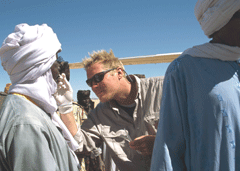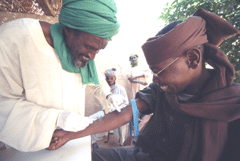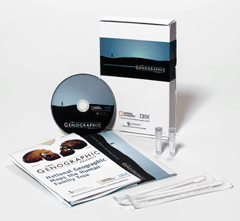Who's Your Daddy?
Air Date: Week of October 19, 2007

National Geographic Genographic Project Public Participation Kit. (Photo: Becky Hale)
A unique research project dubbed "The moon shot of anthropology" promises to answer one of humankind’s most profound philosophical questions: where do we come from? Living on Earth's Bruce Gellerman tests his own DNA and learns about The Genographic Project.
Transcript
CURWOOD: Researchers are about half way through one of the largest science projects in history. Technically, it’s called “The Genographic Project,” but it’s been dubbed “the moon shot of anthropology.” When it’s finished in 2010 scientists will have created the most detailed database ever; mapping the journey humans have made over the millennia as we’ve populated our planet.
You too can become a part of this unique, international research effort as Living on Earth’s Bruce Gellerman learned when he met the head of the Genographic Project.
GELLERMAN: When it comes to adventure and travel, Spencer Wells has a job even Indiana Jones would envy. Wells is explorer in residence for the National Geographic Society—not that he resides anywhere all that long.
WELLS: Just this year alone I’ve circled the globe twice since April. I get a lot of frequent flier miles (laughs).
GELLERMAN: Globe-trotting Dr. Wells is a population geneticist. As director of the Genographic project, he travels to isolated and exotic places in search of indigenous people—people who have pretty much stayed in one place for a long time. When he finds them, Wells tries to convince them to donate a sample of what makes them human: their DNA.

Chad, November, 2005: Spencer Wells collects a cheek swab from a participant in Chad.(Photo: David Evans © 2006 National Geographic)
GELLERMAN: Project researchers at ten centers around the world are collecting genetic samples and tracking mutation markers from a hundred thousand indigenous people—with different skin colors, blue eyes, brown eyes, tall and short. Dr. Wells says scientists are hoping to answer a profound philosophical question: Who’s your daddy?
WELLS: The big surprise, again and again and again, is that despite this incredible diversity, we see around the world—the 6,000 languages and the different physical appearances and so on—we’re all incredibly closely related. We’re 99.9 percent identical at the genetic level.
GELLERMAN: That’s because we share distant common ancestors. Researchers can genetically trace all of the planets 6.5 billion people to one man and one woman. They call them Adam and Eve. They lived in the highlands of east Africa. But 74,000 years ago something dramatic happened that really shook up the gene pool.

Chad, November, 2005: A local health worker takes a blood sample from an indigenous volunteer in Chad. (Photo: David Evans © 2006 National Geographic)
GELLERMAN: Dr. Wells believes the massive die off of modern humans was caused by an ice age triggered by the eruption of a super volcano on the island of Sumatra.
WELLS: The idea is that probably climate was a driving force and the climate was getting really bad at that time and it was tough to find food. And the human population crashed. And we came back from that.
GELLERMAN: Our adaptable genes saved our species. Our mix of brain and brawn changed. We developed more intelligent ways of hunting, learned to make better tools, and developed language. Our ancient ancestors moved out of Africa and began spreading across the globe. It’s all there—our genetic markers map our migration. The stories told by DNA samples collected from all points on the compass.
[DRUMS]
GELLERMAN: In the wilds of Cambridge Massachusetts at the Museum of Science, a crowd of urban dwellers has come to hear Dr. Wells talk about his project—and maybe participate in it.
[SOUND OF CROWD OF PEOPLE]

National Geographic Genographic Project Public Participation Kit. (Photo: Becky Hale)
DHEILLEY: I know about 25 generations of my family on one side that I sort of chase back a thousand years ago. So I’m like, ‘whoa, this would be really cool,’ to be able to see that we’re really all cousins—at most 2000 generations removed.
GELLERMAN: The Genographic test kits are a high-tech way to participate in the project, but at the Museum of Science there’s also a low-tech method. You can taste test your place on the migratory map. Duane Hill works at the museum’s human body connection exhibit, where you can trace your genetic origins using a chemical called PTC.
HILL: PTC is actually a small little molecule, a tiny little molecule. But what we found is that it has very similar shape to some of the molecules that are in the foods that we like to eat or that we don’t like to eat.
GELLERMAN: PTC tastes bitter. Hill says as we migrated out of Africa, the plants we encountered changed. And so did our taste buds.
HILL: I actually have a piece of PTC paper right here.
GELLERMAN: All right, what do I do?
HILL: All you have to do is lay it out on the tip of your tongue and tell me what you taste. What do you taste?
GELLERMAN: Bitter.
HILL: Bitter. You’re a taster. You’re a pretty strong taster. You told me that you tasted it pretty quickly.
GELLERMAN: So according to Hill, on the taste test map that puts my ancestors somewhere in East Europe or the Americas. To pinpoint more exactly, I got one of those genographic test kits and scraped the inside of my mouth for DNA.
[SOUND OF GELLERMAN SCRAPING HIS MOUTH AS HE TRIES TO TALK]
GELLERMAN: I sealed the genetic sample from my cheek in a small vile and sent it to the National Geographic Society for analysis. Project director Spencer Wells says the test kits are a new model for doing science, a collaboration between scientists, indigenous people, and the general public. It’s real-time, interactive research. Money from the sale of the kits will finance the Legacy Fund, an educational project to preserve and protect our genetic and cultural diversity.
WELLS: We’re going through a period of cultural homogenization all over the planet right now. We’re losing languages at an incredible rate—one every two weeks. And we want to do something to raise awareness about that, something to give back to these indigenous groups that we’re collaborating with. You know if we don’t do something to try and save these things we will have lost a huge part of who we are.
GELLERMAN: I’ll find out more about who I am and who’s my daddy in a few weeks when my DNA test results come back from the genographic project. For Living on Earth, I’m Bruce Gellerman.
Links
Living on Earth wants to hear from you!
Living on Earth
62 Calef Highway, Suite 212
Lee, NH 03861
Telephone: 617-287-4121
E-mail: comments@loe.org
Newsletter [Click here]
Donate to Living on Earth!
Living on Earth is an independent media program and relies entirely on contributions from listeners and institutions supporting public service. Please donate now to preserve an independent environmental voice.
NewsletterLiving on Earth offers a weekly delivery of the show's rundown to your mailbox. Sign up for our newsletter today!
 Sailors For The Sea: Be the change you want to sea.
Sailors For The Sea: Be the change you want to sea.
 The Grantham Foundation for the Protection of the Environment: Committed to protecting and improving the health of the global environment.
The Grantham Foundation for the Protection of the Environment: Committed to protecting and improving the health of the global environment.
 Contribute to Living on Earth and receive, as our gift to you, an archival print of one of Mark Seth Lender's extraordinary wildlife photographs. Follow the link to see Mark's current collection of photographs.
Contribute to Living on Earth and receive, as our gift to you, an archival print of one of Mark Seth Lender's extraordinary wildlife photographs. Follow the link to see Mark's current collection of photographs.
 Buy a signed copy of Mark Seth Lender's book Smeagull the Seagull & support Living on Earth
Buy a signed copy of Mark Seth Lender's book Smeagull the Seagull & support Living on Earth

